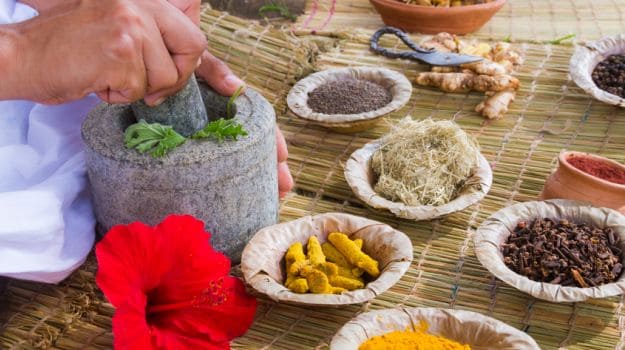An important feature of ancient medicinal systems is that, they treat an individual as a
whole, not just the disease.Then,the treatment is fine-tuned based on the individual’s state
of body. Other conditions include the susceptibility to diseases, mental strength and
lifestyle related factors. Prakriti concept in Ayurveda is a very powerful concept. This
article will give a brief introduction to Prakriti and the diet to be followed.
What is Prakriti?
The word prakriti represents “nature” or the natural form of the constitution and build of the human body. It is derived from two words- Pra meaning the “beginning” and kruthi meaning “to perform”. Put together, it means the natural form. Disease occurs whenever
there is a change in this natural form either at the physiological or psychological level.
Ayurveda focusses on examining this prakriti (ie) the natural state of the individual.
Then,the disease vikruthi will be examined. Modern medicine experts analyze the disease
while an Ayurvedic expert will be interested to know about the individual’s natural body
condition.
Ayurveda sees all the illness or disease based on three basic elements called doshas –
vata, pitta and kapha. An imbalance of any of these will result in some disease.Vata is
responsible for the respiration and movement control. Pitta maintains the body heat and
the Kapha maintains the body form and structure. Kapha dosha comprises of Jala and
Prithvi, Pitta has Tejas and finally Vata is made of Akasha and Vayu.
Qualities of each Prakrithi:
A brief description of each type of prakriti is given below. These qualities can be found in
every individual’s personality. All beings in the universe is composed of 5 basic elements –
namely Vaayu, Akaasha, Jala Teja,and Prithvi.
Vata prakriti
Vata represents dry,mobile, light, expansible, cold, quick,clear,rough and a bit astringent
in taste. Vata individuals are lightly built,will have dry and rough skin, very quick in mental
process and take initiative actions.Vata is usually manifested as dry skin with a thin structure or a lean body. The
nails,hair,eyes and teeth appear dry. Voice is low,weak,hoarse and crackling. Vata
individuals are hyperactive and can work with lesser sleep. Due to the quick action, the
person will show newer initiatives in work. But, the dry quality makes them lose strength
and get tired soon.
Pitta prakriti
Pitta is usually hot,liquid,slightly foul smelling, sour and pungent in taste. So,pitta
individuals sweat a lot and have a higher body temperature than normal ones.
These individuals have a higher metabolic rate, they drink and eat a lot and are very often
thirsty. They have moles or skin eruptions. They have scanty and soft hair and tend to be
grey and bald prematurely. They can’t bear minimum amount of heat. They get provoked
easily and upset about it. The fluid nature makes the muscles and joints, the body parts
very soft and flabby. Their higher metabolic rate leads to excess excretion and
perspiration. The foul smell tends to give a strong body odour to them.
Kapha prakriti
Kapha is unctuous,smooth, sweet in taste,dense, soft, rigid, stable and slow. Kapha
individuals have soft limbs, slower gait and are usually slow to understand. This cold
quality implies that their digestive power or agni is low.
Kapha individuals possess unctuous,soft and oily skin. The steady and stable quality
endows with a well-built, steady body. The dense nature of Kapha provides fullness to the
organs and body. They are usually slow in their activities. They have strong perseverance
and are also emotionally very mild.
![]()

Prakriti and Ayurvedic diet conditions:
Everyone cannot eat the same thing. The Prakriti they have helps in deciding the
appropriate dietary requirement for them. Patients have to modify their regular food intake
if needed. In general, individuals with vata prakriti should take warm,unctuous and sweet
substances. Pitta prakriti individuals should take heavy, cool, bitter, sweet and astringent
food articles. Kapha prakriti individuals should consume warm,dry,light,bitter, pungent and
astringent food items.
Ayurvedic dietary suggestions for vata-pitta,pitta-kapha, kapha-vata type individuals
usually follow a common sense approach.They need to make small changes in their food
choices and the eating habits. A wholesome diet which includes all the food group is very
important. Also, there are guidelines on foods and beverages which should be avoided or
limited. These are recommended based on the unique properties of the dominant dosha of
the individual and analysis of the properties of foods.Because, the food intake directly
influences the doshas and thus results in illness.
The best way to start a day is to have a cup of herbal tea.Use the herbs which pacify the
dominant doshas. Some of the herbs include guduchi,shatavari and vidari.
Before consuming any of these, consult an expert Ayurvedic doctor for the same.Dr. Mini
Nair from Ayurhealing has years of experience in treating dosha related imbalances and
diseases.
Ayurvedic treatment for vata,pita,kapha
Ayurvedic herbs are commonly used to cure a large variety of health problems. These
herbs also play an important role in maintaining a proper health.Ayurvedic herbal products
are more effective in treating the dosha imbalances. Ayurvedic herbs are usually classified
based on their tastes, therapeutic properties and other qualities that represent the doshas.
Some of the most effective herbs for balancing and pacifying a vata-pitta-kapha
constitution are Brahmi,Chamomile, Cinnamon and Ashwagandha. A lot more heerbs are
available at Ayurhealing,one of the best Ayurvedic hospitals in Bangalore.
How to balance Vata,Pita and Kapha
No matter what your dosha type is, Ayurveda provides a lot of recommendations to help
balance them. Make it a daily routine to have a diet that keeps the doshas balanced.Yoga
activities are also effective in preserving the optimal balance of the doshas.
As a vata-pitta-kapha type, one is advised to opt foods which are served at room
temperature (i.e) not so hot or cold. If there is vata or kapha aggravation, have foods which
are served hot. If there is pitta aggravation, increase intake of cool foods or the ones served at room temperature.